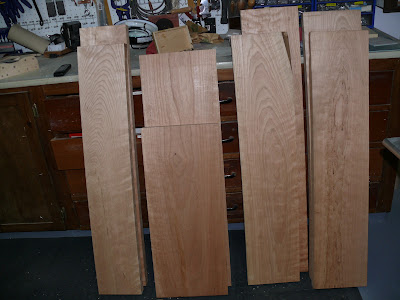I thought before I started this chair project that luthiers were the jig fanatics of the woodworking world, but chairmaking ranks right up there with the "best" of them.
This entry is focusing on some of the jigs I have put together to help chair replication. if I were building one chair, I would be done by now, (hmmmm) but in order to make the chair set more or less identical, a jig would help in the repeatability of the steps and help the chairs look more or less the same when complete. One thing I have learned from all the reading and youtube'g on this subject is to not get too caught up in each chair being an exact match of the others - if it looks fair, it is fair, a common refrain of chairbuilders. I learned this first hand whern I was doing the template take-offs for the chair seat; I thought I had done a pretty good job making the curves on the front the same, they were 3/8" different, something that could not be seen by eye - I guess it was "fair".
 |
End of leg mortise jig showing
indexing strip for alignment
of wedge slot with leg mortise. |
 |
Router template in place to rout
leg mortise |
 |
Completed leg mortise - First one took 3 hours,
remaining 3 on jig took 15 minutes!! |
For the undercarriage of the chair two jigs were required, one to mortise the leg and one to build the bentwood braces for the legs. The leg mortise jig is a box to hold the turned leg in position, without moving and to keep the mortise coplanar with the leg splay. the jig also had to ensure the leg mortise was in alignment with the wedge slot in the leg tenon. I laid this out so all the leg tenons in the top of the chair seat would point toward the centre (in an "X" shape).
 |
| Two jigs for rear and front leg leg angles. |
The next jig required was one to laminate the bentwood leg brackets. These leg brackets are a staple of modern shaker chair/bench construction, I talked about them in the last blog, but wanted to highlight the jig and post a better picture than the phone pic I used earlier.
Since the front and rear legs splay from the cente axis at different angles, two different brackets are required for each chair - 2 for the front and 2 for the back.
Each bracket is 4-5 thin strips of ash cut to 9/16" wide and stacked to 1/2" high and bent around the form and held until the glue is dry with clamps - lots of clamps. Most of these strips were offcuts from the spindle and leg milling operations.

Once removed from the form they are planed down to 1/2" wide to fit in the leg mortise and shaped by hand to ease the edges and improve the look.
This picture is an upclose look (click on it to zoom) of the brackets in place on the prototype chair.
I currently have enough brackets glued up for 3 chairs - 4 to go!
 |
| Chair seat templates |
The final jigs I needed before I could start making chairs were the templates for the seat profiles and shapes. Using plexiglas I laid out the top shape, the leg chamfer, the sides and front profiles from the prototype. This allowed me to refine the shapes for the rough work I did carving the prototype seat.
back to the shop!
 |
Jig's to drill tenon holes through seat top -
One for each corner. |
 |
Spindle Update - this is 70 spindles
with tenons on both ends and turned
rough round - ready to be tapered and sanded. |





























